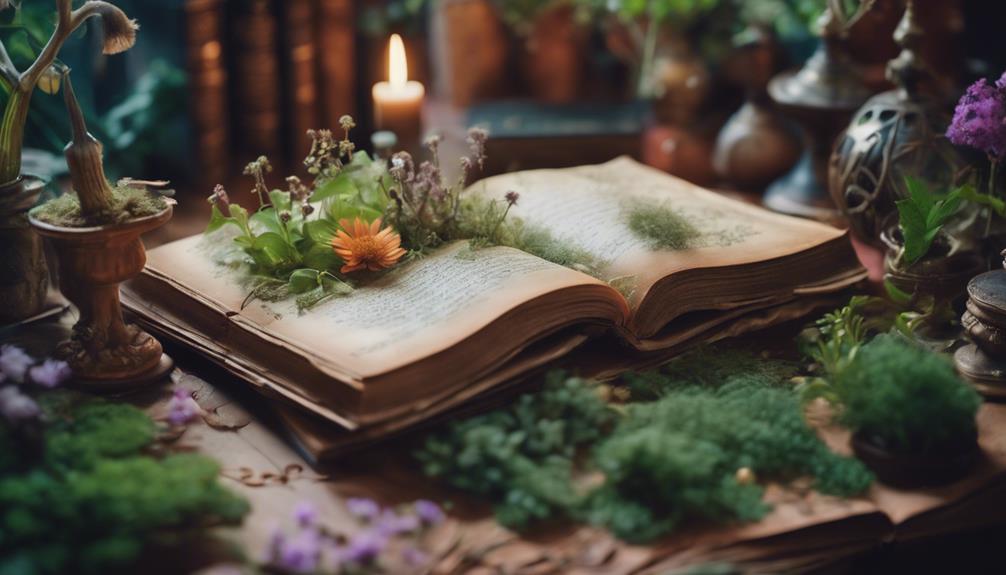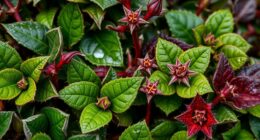We use the flowers of the chamomile plant, which contain bioactive compounds like flavonoids and terpenoids, as the primary medicinal part in herbalism. The yellow center and white petals are rich in essential oils, giving chamomile its apple-like scent. German, Roman, and Moroccan chamomile are popular varieties used for medicinal purposes. By harnessing the medicinal properties of chamomile flowers, we can create teas, extracts, and ointments that promote relaxation, reduce anxiety, and alleviate digestive issues. As we explore the world of chamomile, we'll uncover more about its therapeutic properties and how they can benefit our well-being.
Key Takeaways
• Chamomile flowers are the primary medicinal part of the plant, containing bioactive compounds like flavonoids and terpenoids.
• The yellow center and white petals of the flower heads are rich in essential oils, giving chamomile its apple-like scent.
• Flower heads are harvested and dried to preserve potency, with the entire flower head used in herbal preparations.
• German chamomile, Roman chamomile, and Moroccan chamomile are the primary types of chamomile used in herbalism, each with unique properties.
• The flowers contain volatile oils that give chamomile its medicinal properties, including sedative, anti-inflammatory, and antispasmodic effects.
Chamomile Flowers: The Medicinal Part
As we explore the world of chamomile herbalism, we find that the flowers are undeniably the most crucial part of the plant, holding the key to its medicinal properties. The chamomile flowers are, in fact, the primary medicinal part of the plant used in herbalism.
It's these delicate blooms that contain the bioactive compounds like flavonoids and terpenoids, which are responsible for the plant's therapeutic properties. The flower heads are carefully harvested and dried to preserve their potency, making them ideal for use in teas, ointments, and extracts.
The yellow center and white petals of the chamomile flowers are rich in essential oils, which give them their distinct apple-like scent. Volatile oils present in the flower heads are responsible for this aroma, making chamomile a popular ingredient in aromatherapy.
As we delve deeper into the world of chamomile herbalism, it's clear that the flowers are the star of the show, providing the medicinal benefits that have made chamomile a staple in natural remedies.
Types of Chamomile Used in Herbalism

As we explore the world of chamomile in herbalism, we've seen how the flowers are the primary medicinal part of the plant.
Now, let's examine the different types of chamomile that are commonly used. We'll take a closer look at German chamomile, Roman chamomile, and Moroccan chamomile, highlighting their unique properties and uses.
German Chamomile Properties
We turn to German chamomile, a type of chamomile that has earned its prominent place in herbalism due to its exceptional medicinal properties. Also known as Matricaria chamomilla, German chamomile is the type commonly used in herbalism for its medicinal properties.
The flower heads of German chamomile are the main part of the plant used in herbal preparations, which is why they're harvested and dried for teas, extracts, ointments, and other herbal remedies. German chamomile is rich in bioactive compounds like flavonoids and volatile oils that contribute to its therapeutic effects.
These compounds are responsible for the anti-inflammatory, antioxidant, and calming properties that make German chamomile so valuable in traditional herbal medicine practices. We value German chamomile for its ability to provide soothing relief from inflammation and oxidative stress, making it an excellent addition to our herbal repertoire.
Roman Chamomile Uses
Let's explore the world of Roman chamomile, a type of chamomile that has carved out its own niche in herbalism thanks to its unique properties and uses.
In herbalism, Roman chamomile primarily uses the flower heads of the plant for medicinal purposes. The dried flower heads are commonly used to make teas, ointments, and extracts. We crush the flower heads to extract blue oil, which contains beneficial compounds for health. This oil from Roman chamomile flower heads has anti-inflammatory and antimicrobial properties, making it a valuable herbal remedy.
Additionally, Roman chamomile flowers have a sweet apple-like scent and are known for their calming and soothing effects in herbalism. We often use Roman chamomile to promote relaxation and reduce anxiety due to its calming properties. The anti-inflammatory properties also make it useful in treating skin irritations and wounds.
Moroccan Chamomile Benefits
Discovering the calming and soothing effects of Moroccan chamomile has led to its increasing popularity in herbalism, with its flowers being harvested and dried for medicinal purposes.
We've learned that Moroccan chamomile, also known as Ormenis multicaulis, is a variety of chamomile used in herbalism. The flowers of this plant are valued for their medicinal properties, which are retained when they're harvested and dried.
We appreciate the calming and soothing effects of Moroccan chamomile on the mind and body, making it an excellent addition to aromatherapy and skincare products.
In herbal medicine, Moroccan chamomile is recognized for its anti-inflammatory and antioxidant properties. Its flowers are often used in herbal teas, promoting relaxation and reducing anxiety.
As we explore the benefits of Moroccan chamomile, we're reminded of its versatility and effectiveness in promoting overall well-being. With its calming and soothing effects, it's no wonder Moroccan chamomile has become a staple in many herbal remedies.
Chemical Composition of Chamomile Flowers

As we explore the chemical composition of chamomile flowers, it becomes apparent that the unique blend of flavonoids, terpenoids, and volatile oils is essential for their medicinal properties. These bioactive compounds are the key contributors to chamomile's therapeutic effects. The table below illustrates the primary compounds found in chamomile flowers:
| Compound | Description | Medicinal Properties |
|---|---|---|
| Flavonoids | Plant-based antioxidants | Anti-inflammatory, antibacterial |
| Terpenoids | Volatile organic compounds | Antispasmodic, anti-anxiety |
| Volatile Oils | Essential oils extracted from flowers | Sedative, anti-inflammatory |
The chemical composition of chamomile flowers varies based on factors like species, growing conditions, and processing methods. For instance, the drying process can affect the levels of certain compounds, leading to variations in the final product. Additionally, different species of chamomile, such as German and Roman chamomile, exhibit distinct chemical profiles. Understanding the chemical composition of chamomile flowers is essential for harnessing their medicinal properties.
Therapeutic Properties of Chamomile Tea

As we explore the therapeutic properties of chamomile tea, we'll examine how it can help us in our daily lives.
We'll look at how it can calm nervous tension, soothe digestive issues, and promote restful sleep, all of which are essential for our overall well-being.
Calming Nervous Tension
We've relied on chamomile tea for centuries to calm our frazzled nerves and soothe our anxious minds, and it's no wonder why – its therapeutic properties make it a natural stress-reliever.
The dried flowers of the chamomile plant, with their distinctive yellow center and white petals, hold the key to calming nervous tension. As an herbal remedy, chamomile tea has been used for centuries to reduce stress, anxiety, and insomnia, thanks to its calming and soothing properties.
The active compounds in chamomile tea, such as apigenin, contribute to its anxiolytic effects, helping to reduce anxiety and improve overall mood. When we consume chamomile tea, it helps alleviate symptoms of anxiety, promoting a sense of well-being and relaxation.
The mild sedative effects of chamomile tea make it an ideal choice for unwinding after a long day, allowing us to drift off to sleep with a clear mind.
Soothing Digestive Issues
In addition to calming our minds, chamomile tea's therapeutic properties extend to soothing digestive issues, providing relief from uncomfortable symptoms like indigestion, bloating, and gas. We've found that the active compounds in chamomile flowers can aid in relaxing the digestive tract and reducing inflammation.
As an Herbal remedy, chamomile tea is made from the dried flowers of the chamomile plant, specifically the flower heads, which are used to make a soothing brew. The ingestion of chamomile tea, particularly after meals, may promote digestion and alleviate discomfort associated with digestive problems. Its anti-inflammatory and anti-spasmodic effects on the gastrointestinal system make it an effective natural remedy for soothing digestive issues.
While some people use dried flowers per bath to relax, we've found that drinking chamomile tea is a more effective way to reap its benefits. By incorporating chamomile tea into our daily routine, we can experience relief from digestive discomfort and promote a healthier digestive system.
Promoting Restful Sleep
While we often focus on chamomile's digestive benefits, its calming effects also make it a natural sleep aid, helping us unwind and prepare for a restful night's sleep.
In herbalism, chamomile tea is commonly used to promote restful sleep due to its calming and soothing properties. The flowers of the chamomile plant are harvested and dried to make this tea, which is rich in bioactive compounds like apigenin.
Chamomile tea is known for its mild sedative effects, helping to reduce anxiety, promote relaxation, and improve sleep quality. Consuming chamomile tea before bedtime may aid in falling asleep faster and experiencing a more restful night's sleep.
The therapeutic properties of chamomile tea make it a popular natural remedy for sleep disorders and insomnia. By incorporating chamomile tea into our bedtime routine, we can reap the benefits of a good night's sleep, waking up feeling refreshed and revitalized.
With its calming properties and soothing effects, chamomile tea is an excellent addition to our herbalism practices, promoting restful sleep and overall well-being.
Preparing Chamomile for Herbal Remedies

To prepare chamomile for herbal remedies, we carefully harvest the flower heads when they're near full bloom, as this guarantees maximum potency for our teas, extracts, ointments, and essential oils. This timing guarantees that the bioactive compounds responsible for chamomile's medicinal properties are at their peak.
We're looking for the inflorescences, which consist of a central cone of yellow disc florets surrounded by white ray florets – these are the parts used for herbal remedies. Once harvested, we dry the flower heads to preserve them for later use in herbal preparations. By doing so, we can harness the therapeutic benefits of chamomile, which are attributed to the bioactive compounds present in the flower heads.
In herbalism, the flower heads are the primary part of the chamomile plant used to create teas, extracts, ointments, and essential oils. By following this process, we can access the full potential of chamomile and reap its benefits in our herbal remedies.
Safety Precautions and Contraindications

We must exercise caution when using chamomile in herbal remedies due to several safety concerns and potential contraindications. As we explore the benefits of chamomile, it's vital to acknowledge these risks to guarantee safe and effective use.
For instance, individuals with asthma should avoid chamomile, as it may exacerbate symptoms. Pregnant women should also steer clear of chamomile, as it may increase the risk of miscarriage. Additionally, chamomile's estrogen-like effects warrant caution for those with hormone-sensitive cancers. We should also be aware of potential allergic reactions, particularly for individuals allergic to plants like ragweed, marigolds, or daisies.
When combining chamomile with medications, we must exercise caution, especially with blood thinners, sedatives, and diabetes medications. By understanding these safety precautions and contraindications, we can harness the benefits of chamomile while minimizing potential risks.
Frequently Asked Questions
What Part of the Chamomile Plant Is Edible?
When we think about edible parts of the chamomile plant, we often wonder what's safe to consume.
The good news is that the flowers are perfectly edible and quite versatile. We can use them fresh in salads or desserts, or dry them to make a soothing tea.
The petals have a mild, apple-like flavor that enhances the taste of various dishes and beverages. Plus, they contain beneficial compounds like flavonoids and essential oils that contribute to their medicinal and culinary uses.
What Part of Chamomile Do You Harvest for Tea?
When it comes to harvesting chamomile for tea, we prioritize the flower heads. We pick them near full bloom to guarantee the best quality and aroma.
The flower heads contain the essential oils and compounds responsible for chamomile's medicinal properties. Timing is essential, as harvesting at the right time maximizes the flavor and benefits of chamomile tea.
Do You Use Chamomile Leaves or Flowers?
When it comes to brewing herbal remedies, we're like bees drawn to honey – we head straight for the good stuff.
In this case, that means using chamomile flowers, not leaves. The flowers contain the essential oils and active compounds that make chamomile tea so therapeutic.
We don't bother with the leaves, as they don't pack the same medicinal punch.
What Is Chamomile Used for in Herbalism?
We use chamomile in herbalism to treat various health issues, capitalizing on its therapeutic properties. Specifically, we utilize chamomile to calm anxiety, promote relaxation, and alleviate insomnia.
Additionally, we rely on chamomile to soothe digestive issues, skin irritations, and inflammation, thanks to its anti-inflammatory and antioxidant effects. By harnessing its flavonoids and terpenoids, we can create remedies that address a range of health concerns, making chamomile a valuable asset in herbal medicine.
Conclusion
To sum up, we've revealed the incredible potential of chamomile flowers, the medicinal powerhouse of the chamomile plant. With their soothing therapeutic properties, it's no wonder they've been a staple in herbalism for centuries.
From calming anxious minds to soothing irritated skin, chamomile flowers are the ultimate natural remedy. So, the next time you're feeling frazzled, remember: a cup of chamomile tea is just what the doctor ordered to melt your worries away!










